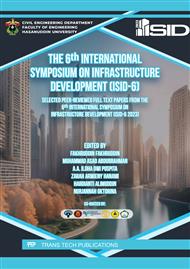p.83
p.91
p.99
p.107
p.115
p.123
p.133
p.141
p.151
Determination of the Groundwater Recharge Areas of Aquifers on the Northern Slope of Lawu Volcano Using the Isotope Method
Abstract:
The Northern Slope of Lawu Volcano has great groundwater potential and is widely used for agricultural irrigation. During the dry season, rainfed agricultural land relies on groundwater extracted from deep wells to fulfil its irrigation water requirements. However, this practice has led to a decline in the groundwater table in the shallow wells used by the local community. Effective groundwater management is essential to strike a balance between groundwater extraction and recharge. The objective of this study is to identify groundwater recharge areas on the Northern Slope of Lawu Volcano. The research methodology involves collecting samples of rainwater and groundwater for the analysis of stable isotopes, specifically Oxygen-18 and Deuterium. These stable isotope values are employed to determine the source of the groundwater. Rainwater samples were taken at seven different elevations, with a range between 54 and 1,052 meters above sea level (masl), to form the Local Meteoric Water Line (LMWL). In addition, groundwater samples were taken to determine groundwater sources, consisting of four samples of spring water, two samples of dug wells, and four samples of deep wells. The results of this study are expected to reveal that the water recharge area originates from an altitude of around 1,500 to 2,900 masl. These findings serve as an initial step in identifying the location of the groundwater protection zone for converse the sustainability of groundwater resources on the Northern Slope of Lawu Volcano.
Info:
Periodical:
Pages:
115-122
Citation:
Online since:
July 2025
Keywords:
Price:
Сopyright:
© 2025 Trans Tech Publications Ltd. All Rights Reserved
Share:
Citation:


